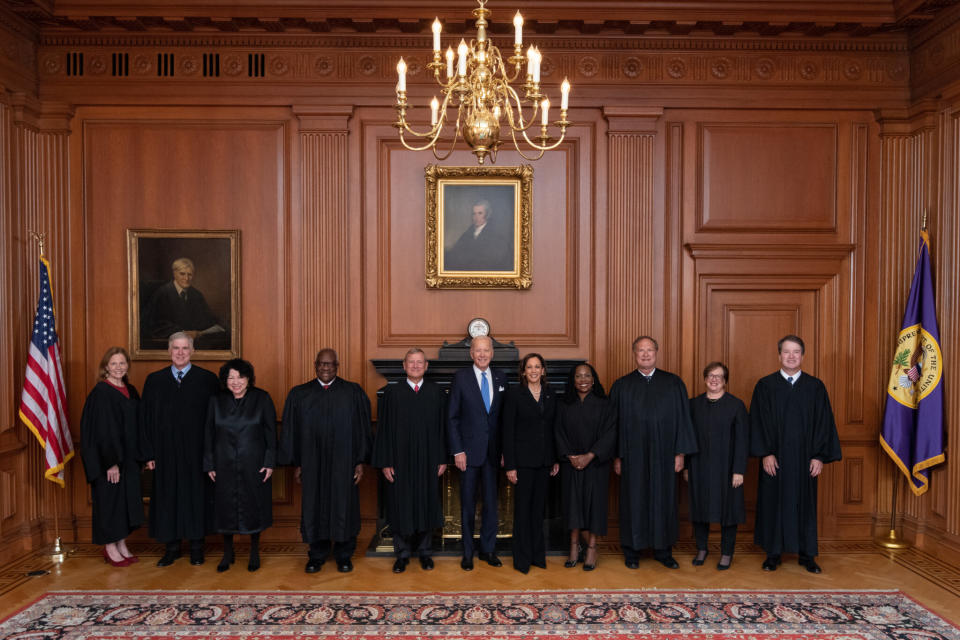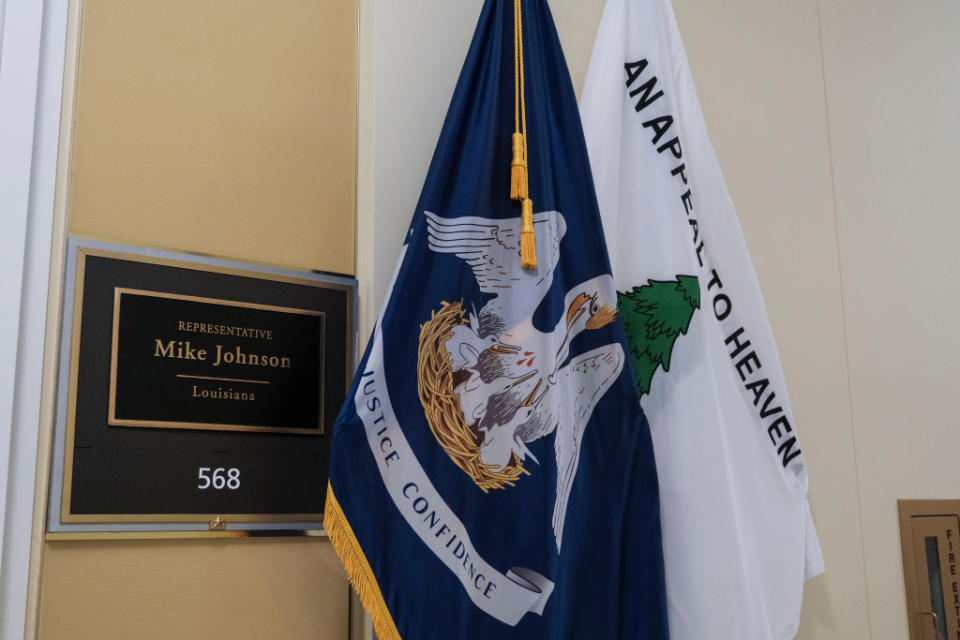This is not a garden flag: the treachery of Alito’s vexing icons

- Oops!Something went wrong.Please try again later.
Crowds arrive for the "Stop the Steal" rally on Jan. 6, 2021, in Washington, D.C. An "Appeal to Heaven" flag is seen being flown by a supporter of then-President Donald Trump. (Spencer Platt/Getty Images)
In 1929, the Belgian surrealist painter René Magritte gave us “The Treachery of Images.” The work is probably better known as “This is Not a Pipe,” because that’s what it says in French beneath the depiction, against a neutral background, of the kind of smoking pipe ubiquitous in the early half of the last century. It’s an image that will be recognized by even the most casual student of modern art or popular culture. The painting is part of the permanent collection at the Los Angeles County Museum of Art, which tells us the work is “a treatise on the impossibility of reconciling word, image, and object.”
Volumes have been written on the meaning of that painting, but my favored interpretation is in Scott McCloud’s “Understanding Comics.” First published in 1993, McCloud created a roadmap to understanding comics and provided a pictorial vocabulary to talk about them. Magritte’s pipe was an icon, not the thing itself, and the images we normally think of as symbols are a special category of icon — flags, religious symbols, company logos — used to represent “concepts, ideas and philosophies.” These non-pictorial icons, McCloud said, unlike Magritte’s pipe, represent invisible ideas.
With that preface we now turn to the Alito flag treachery.
At issue are the invisible ideas represented by flags flown at the homes of Supreme Court Justice Samuel Alito and his wife, Martha-Ann, in 2021 and 2023. If you don’t know about these stories, then you must have either been in a hermit’s cave for the last few weeks, or as clueless about current politics as Justice Alito himself claims to be.
In 2021, at the Alitos’ home in Alexandria, Virginia, Martha-Ann flew for a period of days an upside-down American flag. The inverted flag had been adopted by the “Stop the Steal” election deniers, and some of the Jan. 6 insurrectionists had carried them during the breach of the U.S. Capitol. At the time of the Alito flag display, about a week after the Capitol attack, the Supreme Court was hearing a 2020 presidential election case.
In the other incident, an “Appeal to Heaven” flag was flown at the Alitos’ beach house in New Jersey. Also known as the Pine Tree flag, the Revolutionary War-era device has been co-opted by extremists as a symbol of Christian nationalism.
In both instances, Alito has attributed the display of the flags to Martha-Ann. She told a Washington Post reporter the inverted American flag was an “international signal of distress” raised during a dispute with neighbors. The neighbors apparently had displayed yard signs critical of Donald Trump. The “Appeal to Heaven” flag was also flown by Martha-Ann, according to Justice Alito in a recent letter in which he declined requests from Democratic lawmakers to recuse himself from upcoming election cases involving Trump.
“My wife is fond of flying flags,” he wrote. “I am not.”
Martha-Ann flies a variety of flags, including those for sports teams and seasonal events. Justice Alito was not aware of the upside-down American flag, he said, until it was drawn to his attention.
“A soon as I saw it, I asked her to take it down,” he said, “but for several days, she refused.”
It came down, according to the Washington Post, when in 2021 a reporter asked the Alitos about it and an angry Martha-Ann replaced it with “a novelty flag, the type that would typically decorate a garden.”
In the letter, Justice Alito said he was not familiar with the “Appeal to Heaven” flag when his wife flew it at the vacation home.
“She may have mentioned that it dates back to the American Revolution,” he said, “and I assumed she was flying it to express a religious and patriotic message. I was not aware of any connection between this historic flag and the ‘Stop the Steal Movement,’ and neither was my wife.”
The use of a historic flag by a new group does not “drain” the flag of other meanings, he asserted.
Because my knowledge of the U.S. Flag Code is rusty and my background on flags of the Revolutionary War non-existent, I turned to an expert for information and perhaps a little insight into the invisible ideas represented by flags.
Peter Ansoff is the past president of the North American Vexillological Association and has written what may be the definitive paper on the historic origins of the “Appeal to Heaven” flag. He’s also a history buff who lives in Falls Church, Virginia, about 20 miles from Alexandria. Up front, I need to stress that in my conversation with Ansoff, he did not take one side or another of the Alito controversy.
But he does recognize the power of flags to stir passion.
“That’s why I find flags so fascinating,” he told me. “They’re these pieces of colored cloth, but they stir up very strong emotion, and they generate legal cases and revolutions and all kinds of things. It’s not the physical flag, but what the flag is perceived to represent. Different people can look at it and see different things.”
While there is no extant historical example of an “Appeal to Heaven” flag, Ansoff said, it appears to have first been used on floating Continental batteries — barges equipped with guns — in Boston. The design may have been inspired by the “Liberty Tree” in Boston, an elm from which British officials were hanged in effigy during the Stamp Act resistance. A contemporary artist’s depiction of the flag seems to include a tree that looks more like an elm than a pine, Ansoff said, and the words are indecipherable. The flag may have included the “Appeal to Heaven” legend, which is a reference to the philosopher John Locke, who wrote about the right to revolt against an oppressive government.
The second use of the flag was in 1775, by at least two vessels that were part of George Washington’s cruisers, which were commercial ships fitted out as privateers. There was no Continental Navy yet, and the flags were used to identify the cruisers to one another. When one of the ships — a brig christened the Washington — was captured by the British, apparently without firing a single shot in self-defense, the flag was sent to King George III as a war prize. Ansoff said it is unknown what happened to the “Rebel Flag” after that. It might be in somebody’s attic in England, he said, just waiting to be discovered.
The third use of the “Appeal to Heaven” flag was in 1776 by the Massachusetts State Navy, although the Continental or American flag seems to have been more common. The pine tree, Ansoff said, had already been well established as a symbol for New England.
“Appeal to Heaven” was a commonly used phrase among revolutionary war leaders, Ansoff said, because of Locke’s popularity with colonial separatists.
“The context of what (Locke) was saying is that he was describing the proper function of government as protecting the rights of individual citizens,” he said. “And when the government stops doing that, then it’s the right of citizens to rise up and appeal to heaven for their cause because there is no earthly authority to turn to.”
Ansoff said he did not know if this expressed a religious sentiment or a request for divine intervention, or was simply a way of saying that all appeals had been exhausted.
The public perception of the meaning of flags can change over time, he said.
“A case in point is the Gadsden flag,” he said, referring to the yellow flag with the coiled rattlesnake and the “Don’t Tread on Me” motto. “That one has gone through a process that’s similar to what’s happening with the ‘Appeal to Heaven’ flag now. It played a very minor role in the American Revolution, there were only two ever made, but people latched onto it because of this idea that the government is oppressing us. This identification is not with the real Revolutionary War, but sort of a mythical war.”
As to the upside-down American flag, he said its use came from the naval tradition of signaling to other vessels that urgent help was needed because you were sinking, on fire, or had experienced some other calamity. A number of paintings from the period depict such maritime emergencies.
The use of the inverted flag as a signal of actual distress was incorporated into the 1923 Flag Code, he said, which was written by the American Legion and other non-governmental “patriotic” organizations, including the Daughters of the American Revolution and the Ku Klux Klan. The code was based mostly on a U.S. Army circular from World War I. It was adopted by Congress in 1942, but has been tweaked ever since.
The biggest change in flag law came in 1989, when the U.S. Supreme Court ruled that burning the American flag was a constitutionally protected form of speech.
The “Appeal to Heaven” flag was popularized by evangelical preacher Dutch Sheets, a spiritual warrior of the New Apostolic Reformation, who said it was a symbol of God’s plan to restore America to its Christian founding. In 2015, he wrote “An Appeal to Heaven,” in which he promoted the flag as a symbol of Christian nationalism and urged readers against embracing “any theology or creed that allows God to lose!” Sheets reportedly visited the White House hours before the Jan. 6 attack.
Alito was almost certainly evasive when he claimed, in his recent letter, that he did not know the “Appeal to Heaven” flag had been adopted by election deniers. His denial echoed that of House Speaker Mike Johnson, R-Louisiana, who said the flag — which he flies outside his office at the Capitol — was of historical interest and that he did not know it was associated with the “Stop the Steal” movement.
But assume, for a moment, that both Alito and Johnson are telling the truth, that they were ignorant of the flag’s adoption by election-denying insurrectionists. If ignorance is almost never a legal defense, can it be an ethical one? Shouldn’t a reasonable person expect a justice of the Supreme Court or the speaker of the House, who is second in line of presidential succession, to be familiar with the political context of our times?
The problem here is that it’s difficult to get a grip on the invisible ideas represented by flags and other symbols. They exist in the minds and swell in the breasts of the beholders. The American flag is not the country, but it is something more than Magritte’s pipe. The evolution of an object from signal (or sign) to symbol is the story of human language and our capacity for abstract thought, and we imbue a favored few symbols with the very qualities that are central to our humanity. In some religions, a wafer becomes the body and blood of Christ. In the Flag Code, when the American flag is no longer serviceable because of wear or other disfigurement, it is to be “destroyed in a dignified way, preferably by burning.” We cremate the flag as we cremate our dead.
The “Appeal to Heaven” flag, in its proper historical context, never made it beyond being a practical and literal sign to allied vessels. It is used much the same way now, in signaling sympathy or encouragement to other theocrats. Whether hanging outside an office in the House or topping a flag pole at a vacation home in New Jersey, it invites those of like mind.
Following Sept. 11, the American flag came to represent a unified patriotism and resolve felt by many of us. Those feelings were tempered among some, perhaps, by great wrongs done in the past in our name. Slavery comes most readily to mind. What emotions does the “Appeal to Heaven” flag stir in Alito and Johnson? Are we to believe none?
Martha-Ann Alito is certainly an individual with her own rights to free speech, as Justice Alito points out in his letter. But a reasonable person would conclude that she has considerable influence on her husband, even if he does not care much for flags himself. It would also be reasonable to expect Alito to recuse himself from any case involving Trump or the 2020 election as a way of avoiding any appearance of a conflict of interest.
When your spouse is involved in screaming matches with your neighbors over politics, that is a sure sign of confliction. A lesser judge would be expected to recuse, but Supreme Court justices answer to no earthly authority. Except, perhaps, in the cases of Alito and Justice Clarence Thomas, their wives.
Heaven help the rest of us.
We remain, as we were on Jan. 6, at a perilous juncture in American history. So many flags! At the Capitol that day there was a symbol for every dangerous invisible idea — a Confederate flag being carried through the corridors of the Capitol, the Pine Tree flags, the Gadsden flags, modified Nazi flags, the America First flags. I suspect these flags will proliferate now that a former president and presumptive major party nominee is a convicted felon. No political grievance will be left behind. Every loathsome invisible idea drawn together in one place, an insurrection of incoherent ideologies, all representing a failure of imagination, a weak grasp of history and contempt for democracy.
It is time to leave all of these lesser flags behind. Keep your garden and novelty flags, the butterflies and the jack-o-lanterns, your state flags and those of your favorite sports team. But abandon the use of minor historic flags as signs of current political intent. We must come together under one flag, the American flag, flown right-side up, and put aside these invisible ideas of competing allegiances.
Max McCoy is an award-winning author and journalist. Through its opinion section, the Kansas Reflector works to amplify the voices of people who are affected by public policies or excluded from public debate. Find information, including how to submit your own commentary, here.
The post This is not a garden flag: the treachery of Alito’s vexing icons appeared first on Kansas Reflector.



